After a breakfast on Meissen porcelain at the Café & Restaurant Meissen, the tour continues on Sunday morning. A pleasure tour along the Saxon Wine Route always has to include a visit to the Meissen State Porcelain Manufactory. The bloggers, who hail from Hamburg, Munich, Stuttgart, Weimar and Leipzig, enjoy a delicious breakfast on crockery from the latest ranges of porcelain. They listen keenly to the tableware stories told by guide Beate Debernitz. Before the Meissen Porcelain Factory was founded in 1710, people ate off plates made from wood, clay, tin or even silver. Augustus II the Strong was the first to present his astonished guests with exquisite tableware made from Meissen porcelain.
On a tour through the museum, the group then speeds through 300 years of Meissen’s porcelain and art history. The pieces of porcelain on display are opulent, luxurious and captivating down to the tiniest of details. True craftsmanship. Unfortunately, there is only a little bit of time left for the ‘artCAMPUS’ exhibition, which showcases contemporary artworks by external artists from all over the world, made from Meissen porcelain. The idea? For internationally acclaimed painters and sculptors to collaborate with Meissen artisans to create contemporary pieces of art, such as a sculpture made from precious porcelain fragments.














